|
|
|
Dry stone wall 01 - data and plants
Flora in the Third Dimension with variations of the microclimate
by Michael Palomino (2018)
Share:
|
|
|
Dry stone wall 01 - data and plants
Flora in the Third Dimension with variations of the microclimate
by Michael Palomino (2018)
Share:
|
|
|
1. Facts about dry stone walls
Where dry stone walls occur
In the past, dry-stone walls were often used to build wells, field walls and terraces. The stones lay around the fields, which were then collected and piled up to form walls [web04]. Dry stone walls can also be found on courtyards, on cemeteries, in gardens, in vineyards, as slope supports. Since 1945, however, "civilization" with its concrete culture has torn down more and more dry-stone walls and replaced them with concrete culture, or lets dry-stone walls decay [web02].
Dry stone wall with cushion plants [1] - dry stone walls at the vineyard, region of Wachau (Austria) [2] - Millpo (Ayacucho region, Peru), indigenous farm with dry stone wall [3]
Well, as in Peru it looked in Europe, and the ecosystems were still INTAKT in 1850, when there were no wire fences.
Dry stone wall = "vertical scree field
Dry stone walls are like a third dimension, a vertical scree field [web03], like a rock face or a scree heap [web06, S,2]. Soil in the dry stone wall itself is scarce and lean, rainwater flows off quickly or evaporates. This is why only plants that also like to grow on gravel or stone settle in dry-stone walls [web03].
Dry stone walls are walls with irregular stones without mortar ("built dry"), there are many cracks and gaps for nesting sites and plants [web01]. A dry wall is not always a dry wall, otherwise the wall remains like a desert, this is a NONSENSE [Conclusion Palomino].
Walls can support terrain or stand free ("double-faced" natural stone wall with front view and rear view) [web01].
Dry stone walls should always be combined with rough meadows with many flowers, then the dry stone walls are well populated:
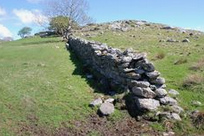

The ideal combination: A solo dry stone wall freestanding in Norway [7] - rough meadow with alpine flowers [8] - fruit tree meadow [9]
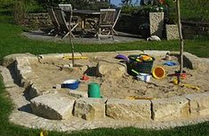
Sandpit with dry stone wall of 1 layer [14] - Permaculture hill bed with dry stone wall 1 layer [106]
2. The plant's settlement (plant's colonisation) of dry-stone walls
The position of a dry stone wall and the colonization
In the crevice and crack system of a dry stone wall all possible microclimates are present, hot, cold, shady, dry, humid, and such a dry stone wall can be also an ideal location for overwintering [web06, p.2]. The position of a dry stone wall determines which seeds will germinate there and which animals will settle there:
Position of a dry wall in north-south direction: The wall is not too hot and is populated by more plants [web06, p.2].
Dry wall in east-west direction with southern exposure: The wall becomes very hot since midday. Many plants do not tolerate the extreme heat [web06, p.2]. Here will settle: wild bees, wasps, bumble bees (bumble bee queens also spend the winter there), lizards, blindworms, snakes (the reptiles often spend the winter there) [web06, p.9],
Dry wall in east-west direction with north exposure: The wall always remains in the shade. Here toads will settle [web06, p.10].
The more developed the ecosystem is around a dry wall with flower meadows, the more animals will populate the dry wall. A dry wall on a road [or on a sterile lawn] will hardly be populated [web06, p.9].



Dry stone wall next to sterile lawn is NONSENSE [4] - dry stone wall in a wild garden is VERY GOOD [5] - dry stone wall art with salto without rough meadow is USELESS, Jhonny Clasper, Yorkshire [6] - dry stone wall around flower bed herbal spiral is VERY GOOD [17]
3. The plant's settlement (plant's colonisation) of freestanding dry stone walls
The freestanding dry stone wall with ground contact only at it's basement
A freestanding solo dry stone wall only shows moisture in the lowest part where there is earth contact [web06, p.2]. Here only plants can exist, which survive the dryness with maneuvers and tricks, the "Xerophytes" [web06, p.2].
So these cars there in the forest are going to rot anyway and will be "eaten" by nature - very good.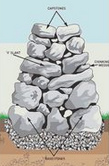


Solo freestanding dry stone wall, inclined in itself, the cross-section [11] - Solo freestanding dry stone wall, inclined in itself with a soil core and a gravel drainage, cross-section [12] - Dry stone wall freestanding, location: Friesenwall natural garden (Germany) [16] - Dry stone wall art, a tree with various stones [17]



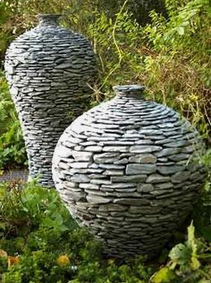
Dry wall art: Dry wall fountain house, Verrière, France [19] - dry wall VW beetle in the forest VERY GOOD [20] - dry wall pickup near shrubs in a park VERY GOOD [21] - dry wall amphorae in a wild garden VERY GOOD [22]
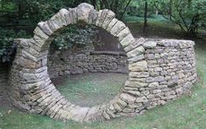

Dry stone wall marking a courtyard at the edge of a forest [25] - Construction of a dry wall bridge [26]
The strategies of drought-resistant plants on a dry wall
Drought resistant plants (xerophytes) have different strategies to survive the drought:
-- they develop disproportionately long roots with a connection to the soil (e.g. cinquefoil),
-- they live with a sponge structure that is contracting in the heat (e.g. mosses and cushion plants, saxifrage species)
-- they roll up the leaves (Rustyback (Ceterach officinarum)) as a protection from the sun
-- they fold the leaves together (wall grasses) as a protection from the sun [web06, p.5]
-- some plants also develop hairy leaves against air currents to reduce evaporation (e.g. the orange-red hawkweed)
-- some plants blossom very early, scatter the seeds in early summer, then they die and the seeds germinate as soon as there is enough moisture again, e.g. thale cress (Arabidopsis thaliana), clammy chickweed (Cerastium glomeratum), common whitlowgrass (Erophila verna), saxifrage species (Saxifraga)
-- some plants develop wax-like coated leaves against dryness like leather: navelwort (Umbilicus rupestris), common sowthistle (Sonchus oleraceus), saxifrage (Saxifraga), dyer's woad (Isatis tinctoria) and ivy (Hedera helix)
-- other plants minimize water loss by evaporation by varying the plant sap, e.g. greater celandine (Chelidonium majus) with an orange milky liquid. The sap with a high salt content attracts moisture from the environment (hygroscopic).
-- other plants store water for the dry summer in fleshy leaves, e.g. the wall pepper species (Sedum), the house root species (Sempervivum) etc. [web06, p.6].
-- some plants also combine some strategies to survive in summer [web06, p.6]
4. The plant colonisation of dry stone walls with lateral ground contact and a humid microclimate
A dry stone wall in contact with the ground is a mosaic of habitats in a very small space. Factors are the type of wall (retaining wall or free-standing wall), age, rock (acid or alkaline environment), orientation and environment in the microclimate. Dry walls in the shade remain constantly cool, dry walls on sunny sides in summer may heat up to 70ºC and are also warmed in winter days and then are cooling during the cold night. Dry walls on sunny sides have a daily temperature fluctuation of 30 to 50ºC on it's surface. Inside, however, the fluctuation is only slight. At night the heat is radiated to the environment. The more plants grow on the dry stone wall, the less strong are the temperature fluctuations. On a sunny south side typical plants are growing, and on the north side other typical plants are growing. Without backfilling and without a separation from the earthy ground, the wall is always in contact with moisture, which leads to a balanced, moist microclimate. With strong solar irradiation the surface temperature is thus high, in the inside however it remains nevertheless balanced cool and damp. On a shady dry stone wall mosses and ferns will settle, on a sunny side other plants [web06, p.2].
In order to accelerate the colonization of a dry wall, one can integrate old stones that are already covered with algae, lichen and moss, or one can build the entire wall only from old stones. Rebuilding an old dry-stone wall can be done remaining some old sections of the wall renewing the big part of it so the settlement colonization of the new parts will come faster [web06, p.9].
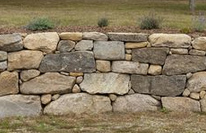
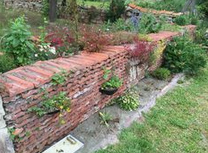
Dry stone wall with mixed stones [10] - Dry stone wall made of old roof tiles [13]
In limestone (chalkstone) regions dry-stone walls are very well overgrown, in less calcareous limestone regions less. In the process, entire groups of plants (plant communities) are forming, which are typical for certain locations. These communities in rock crevices and in wall crevices are developing during over 100 to 500 years. The composition varies depending on the location. Investigating the plants one can recognize the location conditions, so that the plants serve as "indicators" [web06, p.7].
The dry wall with lateral earth contact in the free nature: bacteria - lichens - mosses - moss cushions - high plants
The order of colonization comes with bacteria - lichens - then mosses - and high plants grow on the moss cushions. The entire plant colonization process takes 100 to 500 years [web06, p.5].
Details:
First bacteria are coming penetrating into pores and crevices, the stones are changing their colour slightly. After death of the bacteria these bacteria leave behind carbon (C) and nitrogen (N), the prerequisites for the formation of algae (mostly blue-green algae or diatoms) and fungi, preferably on shady eastern and nortern sides [in the upper northern hemisphere, in the southern hemisphere on eastern and southern sides]. After a few years, lichens are forming (growth 1-4mm per year), a symbiosis of algae and fungi: first crustal lichens, then leaf lichens, their age can be up to 100s of years. With this the stones are attacked mechanically and chemically. Some lichens (mostly crustal lichens) also grow in polluted air from industrial areas. After a few years parts of the lichens break off, collect on projections and in stone gaps of the dry walls and rot there. Earth heaps are formed where mosses grow [web06, p.3].
Mosses on dry stone walls: Many grow only on shady sides, but some also on sunny sides. During dry periods, they slow down their metabolism and contract to survive. Mosses with their cushion shape store water like a sponge and reduce water evaporation [web06, p.3-4]. Algae, lichens and mosses prepare the habitat. The little earth piles are used now by pioner plants like grasses, ferns (e.g. wall rue) and flowering plants (cinnamonwort, glass herb, sedum, spring whitlowgrass, houseleek), later others. In the end even shrubs and trees grow on the dry wall (woody plants), which then damage and destroy the wall with their roots [web06, p.4].
Plants from Southern Europe can grow in Central Europe on the sunny side of dry walls [web06, p.5].
5. The dry stone wall with lateral ground contact in your own garden
Dry wall with different coloured stones, Friesenwall natural garden (Germany) [15]
Every garden can also be planted with a dry wall and wall plants, so that insects and birds are attracted [web04]. Self-built dry stone walls can be planted during construction during. Gaps that remain serve as shelters for insects, larger cavities in the first road for toads and in the middle and upper floors for lizards [web04].
A dry wall in a garden with all the nesting possibilities can become an oasis for plants and animals [web04]. You can let your garden "grow" upwards into the vertical dimension with a dry wall [web05].
With dry stone wall plants, special care is possible:
-- Regularly remove couch grass and grasses to allow to grow to small and sun-hungry plants to grow better [web03].
-- Cut off withered flowers and seed stands so that the plants form new flowers [web03]
-- In this way also the shadow cast is reduced [web03]
-- In early spring (February) plants can be cut down to a few centimetres [web03].
A freestanding dry wall is moist only in the lowest part and in all other parts it's very dry without much plant settlement possibilities [web06, p.2].
The casting of a dry stone wall with lateral ground contact
When it rains or when the wall is watered from above, the upper plants get more water. So you put those plants there that need more water. When watering the wall with a shower from the side a lot of water evaporates uselessly. Drop irrigation is also possible [web04].
6. The vegetation on a dry stone wall with lateral ground contact
The wall crown with it's plants that tolerate extreme heat and wind
Here are the strategies of the plants indicated how they survive the drought. Some plants also combine some strategies [web06, p.6]:
-- houseleek species (Sempervivum) [web04,web05] are storing water in fleshy leaves [web06, p.6]
-- low-growing stonecrops such as
-- Goldmoss stonecrop (Sedum acre) [web04,web05]; yellow wall pepper on the wall crown [web02]; types of stonecrop (Sedum) that are storing water in fleshy leaves [web06, p.6]
-- White stonecrop (Sedum album) [web04]
-- Caucasian stonecrop (Sedum spurium) [web04]
-- Colorado stonecrop (Sedum spatulifolium) [web04]
-- Ivy (Hedera helix) develops leathery leaves [web06, p.6]
-- Dyer's woad (Isatis tinctoria) develops leathery leaves [web06, p.6]
-- Cinquefoil (potentilla) with long roots [web06, p.5]
-- Common whitlowgrass (Erophila verna) blooms early to seed before summer heat [web06, p.6]
-- Common sowthistle (Sonchus oleraceus) develops leathery leaves [web06, p.6]
-- Clammy chickweed (Cerastium glomeratum) blooms early to seed before summer heat [web06, p.6]
-- Wall grasses fold the leaves together to protect them from the sun [web06, p.5]
-- Mosses have a sponge structure that contracts in the heat [web06, p.5].
-- Orange hawk bit (Hieracium aurantiacum): develops hairy leaves against air currents to reduce evaporation [web06, p.6]
-- Mosses have a sponge structure that contracts in the heat [web06, p.6]
-- Upholstery plants have a sponge structure that contracts in the heat [web06, p.5]
Ivy (Hedera helix) [33] Dyer's woad (Isatis tinctoria) [34] Cinquefoil (potentilla) at a stone [27] Common whitlowgrass (Draba verna, Erophila verna) [35] Common sowthistle (Sonchus oleraceus) [36]
Clammy chickweed (Cerastium glomeratum) [37]
Wall grasses?
Moses at a dry stone wall [38]
Orange hawk bit (Hieracium aurantiacum) [39]
Upholstery plants, e.g.
red tufted alpine saxifrage
(Saxifraga oppositifolia vacarie) [40]
-- Greater celandine (Chelidonium majus) varies the sap to minimize evaporation. The sap with a high salt content attracts moisture from the environment (hygroscopic) [web06, p.6]
-- Thale cress (Arabidopsis thaliana) blooms early to seed before summer heat [web06, p.6]
-- Rustyback (Asplenium ceterach): rolls up the leaves to protect them from the sun [web06, p.5]
-- Saxifrage (Saxifraga) with sponge structure that contracts in heat [web06, p.5]
-- Saxifrage species (Saxifraga) flower early to seed before summer heat [web06, p.6]
-- Saxifrage species (Saxifraga) with leathery leaves [web06, p.6]
-- Navelwort (Umbilicus rupestris) with leathery leaves [web06, p.6]
Greater celandine (Chelidonium majus) [41]
Thale cress (Arabidopsis thaliana) [42]
Rustyback (Asplenium ceterach) [43]
Navelwort (Umbilicus rupestris) [48]
Rose saxifrage (Saxifraga decipiens) [44]
Grapes saxifrage (Saxifraga spaniculata) [45]
Burser's saxifrage (Saxifraga burseriana) [46]
Mossy saxifrage (Saxifraga bryoides) [47]
Upper area (upholstered perennials [web04])
Planted plants that need more moisture, more space and by their cushion formation have a good effect in the upper partof the wall:
-- Upholstered perennials [web04], e.g.
-- Common mountain alyssum (Alyssum montanum) [web04]
-- Silvermound (Artemisia schmidtiana) [web04]
-- Blue cushions / blue pillow (Aubrieta x cultorum) [web04,web05]
-- Snow-in-Summer (Cerastium tomentosum) [web04]
-- Sea thrift (Armeria maritima) [web04]
-- Rock soapwort (Saponaria ocymoides) [web04]
-- Suendermann dryad mountain avens (Dryas x suendermannii) [web04]
-- Serbian bellflower (Campanula poscharskyana) [web04]
-- Maiden pink (Dianthus deltoides) [web04]
Common mountain alyssum (Alyssum montanum) [49]
Silvermound (Artemisia schmidtiana) [50]
Blue cushions / blue pillow (Aubrieta x cultorum) [51]
Snow-in-Summer (Cerastium tomentosum) [52]
-- Cheddar pink (Dianthus gratianopolitanus) [web04]
-- Evergreen candytuft (Iberis sempervirens) [web04]
-- Creeping phlox / mountain phlox (Phlox subulata) [web04]
-- Prostrate speedwell (Veronica prostrata) [web04]
Cheddar pink (Dianthus gratianopolitanus) [58]
Evergreen candytuft (Iberis sempervirens) [59]
Creeping phlox / mountain phlox (Phlox subulata) [60]
Prostrate speedwell (Veronica prostrata) [61]
If cushion plants were installed in the lower area, they would cover the foot of the wall and would no longer make the wall appear as a wall [web04].
Lower area ("foot planting" [web04])
-- Columbine [web03]
-- Mullein [web03]
-- Evening primrose [web03]
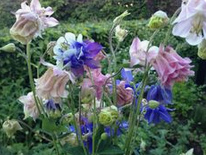
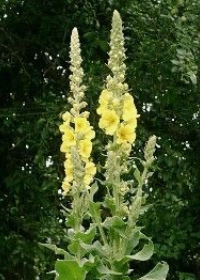
Colombines in different colors [62] - mullein [63] - evening primrose [64]
Plants planted growing up to 5cm for the lower part of the wall ("tread plants"):
-- Glaucous pirri-pirri-bur (Acaena caesiiglauca) [web04]
-- Brass buttons (Cotula squalida) [web04]
-- English camomile / chamomile (Chamaemelum nobile) [web04]
-- Wild thyme (Thymus praecox) [web04]
-- Rock cress / Old Gold (Arabis ferdinandi-coburgii) [web04]
-- Breckland wild thyme (Thymus serpyllum) [web04]
-- Wooly thyme (Thymus praecox ssp. pseudolanuginosus) [web04]
-- Hairless leptinella (Cotula dioica) [web04]
Glaucous pirri-pirri-bur (Acaena caesiiglauca) [65]
Brass buttons (Cotula squalida) [66]
English camomile / chamomile (Chamaemelum nobile) [67]
Wild thyme (Thymus praecox) [68]
Rock cress / Old Gold (Arabis ferdinandi-coburgii) [69]
Breckland wild thyme (Thymus serpyllum) [70]
Wolly thyme (Thymus praecox ssp. pseudolanuginosus / Thymus pseudolanuginosus) [71]
Hairless leptinella (Cotula dioica), zoom [72]
For the whole wall
-- White stonecrop (Sedum album) in the cracks and crevices [web02]

White stonecrop (Sedum album) in cracks [30,73]Sunny side without special indication of location
-- Cliff maids (Lewisia cotyledon) [web05]
-- Dalmatian cranesbill (Geranium dalmaticum) [web03,web05]
-- Basket of gold / gold-dust (Alyssum saxatile) [web05]
-- Mountain rock cress (Arabis caucasica) [web05]
-- Dalmatian bellflower (Campanula portenschlagiana) [web05]
-- Gold Dust [web05] (Saxifraga x eudoxiana 'Haagii') [web08]
-- Tasteless stonecrop (Sedum secxangulare) [web05]
-- Sea thrift (Armeria maritima) [web03]
Cliff maids (Lewisia cotyledon) [74]
Dalmatian cranesbill (Geranium dalmaticum) [75]
Basket of gold / gold-dust (Alyssum saxatile) [76]
Mountain rock cress (Arabis caucasica) [77]
Dalmatian bellflower (Campanula portenschlagiana) [78]
Gold Dust (Saxifraga x eudoxiana 'Haagii') [79]
Tasteless stonecrop (Sedum secxangulare) [80]
Sea thrift (Armeria maritima) [53]
-- Snow-in-Summer (Cerastium tomentosum) [web05]
-- Whitlowgrass [web03], e.g. Common whitlowgrass (Draba verna, Erophila verna) [35]
-- Goldmoss stonecrop (Sedum acre) [web03]
-- Yellowtuft (Alyssum murale) [web05]
-- Mossy saxifrage (Saxifraga x arendsii) [web05]
-- Cheddar pink (Dianthus gratianopolitanus) [web03]
-- Creeping phlox / mountain phlox (Phlox subulata) [web05]
-- Alpine gypsophila (Gypsophila repens) [web03]
Snow-in-Summer (Cerastium tomentosum) [52]
Common whitlowgrass (Draba verna, Erophila verna) [35]
Goldmoss stonecrop (Sedum acre) [29]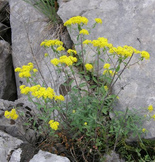
Yellowtuft (Alyssum murale) [81]
Mossy saxifrage (Saxifraga x arendsii) [82]
Cheddar pink (Dianthus gratianopolitanus) [58]
Creeping phlox / mountain phlox (Phlox subulata) [83]
Alpine gypsophila (Gypsophila repens) [84]
-- Balkan yarrow / Greek yarrow (Achillea ageratifolia) [web05]
-- Red valerian / kiss-me-quick (Centranthus ruber) [web03]
-- Myrtle spurge / blue spurge (Euphorbis myrsinites) [web05]
-- Ivy-leaved toadflax / Oxford ivy / pennywort (Linaria cymbalaria) [web05]
Balkan yarrow / Greek yarrow (Achillea ageratifolia) [85]
Red valerian / kiss-me-quick (Centranthus ruber) [86]
Myrtle spurge / blue spurge (Euphorbia myrsinites) [87]
Ivy-leaved toadflax / Oxford ivy / pennywort (Linaria cymbalaria) [88]
Shady side without special indication of location
Just look for "shadow plants" and all is coming:

Bridge as dry stone wall construction [24] - comes an earthquake comes a fall...
-- Maidenhair spleenwort (Asplenium trichomanes) [web02] in half sunny and shady positions [web09]
-- Spreading rock cress (Arabis procurrens) [web03], one of the cress sorts [web10]
-- Rock fumewort / yellow corydalis (Pseudofumaria lutea) [web03,web05]
-- Houseleek / live-forever (rare) [web02], e.g. Sempervivum lipari [92]
-- Mossy saxifrage (hybrides of Saxifraga x Arendsi) [web03]
-- Red robin / fox geranium (Geranium robertianum) [web03]
-- Saxifrage [web02], e.g. mossy saxifrage in the shadow [web11]
-- Wild strawberry (Fragaria vesca) [web03]
-- Ivy-leaved toadflax / coliseum ivy / Oxford ivy / pennywort (Cymbalaria muralis) [web02,web03]
Maidenhair spleenwort (Asplenium trichomanes) [89]
Spreading rock cress (Arabis procurrens) [90]
Rock fumewort / yellow corydalis (Pseudofumaria lutea) [91]
Houseleek, e.g. Sempervivum lipari [92]
and fungi [web06, p.3].Without indicaiton of any location
-- Lichen [web03], z.B. crinkled snow lichen (Flavocetraria nivalis) [web12]
-- Ground-ivy / catsfoot (Glechoma hederacea L.) [web03]
-- Carthusian Pink (Dianthus carthusianorum) [web03]
-- Campion [web03], e.g. moss campion / cushion pink (Silene acaulis) [web13]
-- Wall-rue (Asplenium ruta-muraria) [web03]
-- Viper's bugloss [web03], e.g. Italian viper's bugloss (Echium italicum) [web14].
Wall-rue (Asplenium ruta-muraria) [100]
Mosses on dry stone wall [38]
Italian viper's bugloss (Echium italicum) [101]
7. The plant's settlement of dry stone walls in dry southern Europe
In southern Europe also grow in stone cracks or on the wall crown
-- Sage [web03]
-- Thyme [web03]
-- Rosemary [web03]
-- Savory [web03].
On the dry stone wall, they form "firm, resistant shoots and usually survive the winter better than in the garden bed". [web03]
Remove unwanted plants from the dry stone wall
Unwanted plants settle in the narrowest cracks, which are not planted, they can be plucked away or removed with a thin peeling knife. The bricks should not be moved during this maneuver. If the plant is already so rooted that it can no longer be removed, simply cut it off as far as possible [web04].
The "wall flower"
Wallflower=Ivy-leaved toadflax / coliseum ivy / Oxford ivy / pennywort (Cymbalaria muralis) [web15]
8. Plant communities on a dry stone wall with ground contact
Asplenietea trichomanis (class): crevices and masonry joint societies
Class character types:
-- Maidenhair spleenwort (Asplenium trichomanes)
-- Rustyback (Ceterach officinarum)
-- Rose saxifrage (Saxifraga decipiens) [web06, p.8]
Comparison of plant communities between limestone (chalkstone) and silicate areas
Limestone crevice societies
Potentilletalia caulescentis (congregation): Limestone crevice societies
Order character types:
-- Ivy-leaved toadflax / coliseum ivy / Oxford ivy / pennywort (Cymbalaria muralis)
-- Wall-rue (Asplenium ruta muraria)
-- Milkwhite rock jasmine (Androsace lactea)
-- Alpine fern (Asplenium fontanum)
-- Mountanous daphne (Daphne alpina)
-- Glaucous bluegrass (Poa glauca)
-- Cinquefoil (Potentilla caulescens)
-- Dwarf buckthorn (Rhamnus pumilus)
-- Grapes saxifrage (Saxifraga spaniculata)
-- Tortula moss (Tortula muralis)
-- kind of moss (Homalothecium lutescens)
-- kind of moss (Ctenidium molluscum)Silicate crevice societies
Androsacetalia vandellii (order), silicate rock cracks societies
Order character types:
-- Northern spleenwort / forked spleenwort (Asplenium septentrionale)
-- German spleenwort (Asplenium alternifolium)
-- Arctic alpine forget-me-not / king-of-the-Alps (Eritrichium nanum)
-- Oxford rampion / horned rampion (Phyteuma scheuchzeri)
-- Bristly haircap (moss) (Polytrichum piliferum)
-- Redshank / purple forkmoss / ceratodon moss / fire moss (Ceratodon purpureus)
-- Racomitrium moss (Racomitrium canescens)Potentillion caulescentis (congregation): Cinquefoil-rock cracks society - limestone rock cracks society, sunny places
Congregation differential types:
-- Rock fumewort / yellow corydalis (Corydalis lutea)
-- Milkwhite rock jasmine (Androsace lactea)
-- Dwarf rock cress (Arabis pumila)
-- Dolomite spleenwort (Asplenium seelosii)
-- Northern rock cress (Cardaminopsis petraea)
-- Spiny appointed sedge (Carex mucronata)
-- Yellow whitlow-grass (Draba aizoides)
-- Engadine whitlowgrass / whitlow grass (Draba ladina)
-- Sauter's whitlowgrass (Draba sauteri)
-- Tomentose draba / woolly draba (Draba tomentosa)
-- Alpine fescue (Festuca alpina)
-- Narrow bloody fescue (Festuca stenantha)
-- Hawkweed (Hieracium bupleuroides)
-- Lower hawkweed [?] (Hieracium humile)
-- Kernera (Kernera saxatilis)
-- Men's shield sandwort [?] (Minuartia cherlerioides)
-- Rock sandwort (Minuartia rupestris)
-- East Alps cinquefoil [?] (Potentilla clusiana)
-- Burser's saxifrage (Saxifraga burseriana)
-- Thick leaves sedum [?] (Sedum dasphyllum)
-- Alpine valerian (Valeriana saxatilis)
-- Yellow veronica (Veronica lutea)Androsacion vandellii (congretation), Alpine cliff fern rock cracks society, silicate rock cracks society, sunny places
Congregation differential types:
-- Northern spleenwort / forked spleenwort (Asplenium septentrionale)
-- Vandellis' androsace (Androsace vandellii)
-- Alpine artemisia (Artemisia mutellina)
-- Black spleenwort (Asplenium adiantum-nigrum)
-- Gaudin's fleabane (Erigeron gaudinii)
-- Alpine Engadine wallflower [?] (Erysimum rhaeticum)
-- White hawkweed (Hieracium intybaceum)
-- Red rock primerose [?] (Primula hirsuta)
-- Golden root / rose root / roseroot (Rhodiola rosea)
-- Mossy saxifrage (Saxifraga bryoides)
-- Pyramidal saxifrage (Saxifraga cotyledon)
-- Sponheim saxifrage [?] (Saxifraga sponhemica)
-- Alpine woodsia (Woodsia alpina)
-- Südlicher Wimperfarn,
-- Oblong woodsia (Woodsia ilvensis)
-- Bristly haircap (moss) (Polytrichum piliferum)
-- Redshank / purple forkmoss / ceratodon moss / fire moss (Ceratodon purpureus)
-- Racomitrium moss (Racomitrium canescens)Cystopteridion fragilis (congregation): Bladderfern rock cracks society, limestone rock cracks society, shady places
Congregation character types:
-- Bladderfern (Cystopteris fragilis)
-- Green spleenwort (Asplenium viride)
-- Green spleenwort [?] (Asplenium fissum)
-- Short head sedge [?] (Carex brachystachys)
-- Alpine bladderfern (Cystopteris regia)
-- Mossy sandwort (Moehringia muscosa)
-- Hart's-tongue / hart's-tongue fern (Phyllitis scolopendrium)
-- Smooth cliff fern (Woodsia pulchella)Asarinion procumbentis (congregation), silicate rock cracks society, shady places
Congregation character types:
-- Blunt-leaved or Lanceolate spleenwort (Asplenium billotii)
Serpentine rock:
-- Brown green serpentine rock dwelling fern [?] (Asplenium adulterinum)
-- Serpentine maidenhair fern [?] (Asplenium cuneifolium)
[web06, S.8]
<< >>
|
|
|
Sources
[web01] Instruction to build a natural stone wall: https://www.gartenwerk-naturstein.de/service/verlegetipps-aufbauanleitung/natursteinmauer.html
[web02] Living walls (Lebendige Mauern): https://www.nabu.de/umwelt-und-ressourcen/oekologisch-leben/balkon-und-garten/gartenelemente/00655.html
[web03] Green life on a dry stone wall (Grünes Leben auf der Trockenmauer): https://www.krautundrueben.de/gruenes-leben-auf-der-trockenmauer
[web04] Dry stone wall habitat (Lebensraum Trockenmauer): https://www.gartenfreunde.de/gartenpraxis/gartengestaltung/lebensraum-trockenmauer/
[web05] Simple gardening - planting dry stone walls (Einfach gärtnern - Trockenmauer bepflanzen):
https://phlora.de/einfach-gaertnern-trockenmauer-bepflanzen/
[web06] Ecology of dry stone wall (Ökologie der Trockenmauern):
https://stonewalls.ch/sites/default/files/public/documents/downloads/Trockenmauer_Oekologie_D.pdf
[web07] https://www.pinterest.de/pin/517562182153194667/
[web08] http://www.juergens-gartenwelt.de/Steingarten/Steinbrechs/saxifraga_x_eudoxiana_haagii1.html
[web09] CIA Wikipedia with dry stone wall as natural stone wall building (Natursteinmauerwerk): https://de.wikipedia.org/wiki/Natursteinmauerwerk
[web10] Sorts of rock cress (Gänsekresse-Arten): https://de.wikipedia.org/wiki/Gänsekressen
[web11] Mossy saxifrage: https://www.pinterest.de/pin/109001253458111658/
[web12] Crinkled snow lichen (Flavocetraria nivalis): https://de.wikipedia.org/wiki/Flavocetraria_nivalis
[web13] Cushion pink: https://de.wikipedia.org/wiki/Stängelloses_Leimkraut
[web14] Pale bugloss: https://de.wikipedia.org/wiki/Italienischer_Natternkopf
[web15] Wall flower = Ivy-leaved toadflax / coliseum ivy / Oxford ivy / pennywort (Cymbalaria muralis):
https://www.gartenflora.de/mein-garten/blatt-bluete/zimbelkraut-das-einzig-wahre-mauerbluemchen/
Photo sources
[1] Dry wall with flowers: https://www.pinterest.de/pin/451485931366863923/
[2] Dry stone walls at the vineyard in Wachau in Austria: https://www.pinterest.de/pin/789044797191021810/
[3] Millpo (Ayacucho region, Peru), courtyard with dry stone wall: photo by Michael Palomino 2007
[4] Dry wall next to sterile lawn is NONSENSE: https://www.pinterest.de/pin/402931497888474620/
[5] Dry wall in a wild garden: https://www.pinterest.de/pin/376332112591064962/
[6] Dry wall art with somersault: https://www.pinterest.de/pin/778208010587646482/
[7] Drywall solo freestanding in Norway: https://www.pinterest.de/pin/239535273914216594/
[8] Lean meadow with alpine flowers: https://www.pinterest.de/pin/275493702183217237/
[9] Fruit tree meadow: https://www.pinterest.de/pin/400679698088517972/
[10] Dry stone wall with mixed stones: https://www.pinterest.de/pin/430586414365981870/
[11] Dry wall solo, free-standing, inclined in itself, cross-section: https://www.pinterest.de/pin/591730838515196407/
[12] Dry wall, solo, free-standing, inclined, with soil core and gravel drainage, cross-section: https://www.pinterest.de/pin/349662358550773992/
[13] Dry wall made of old roof tiles: https://www.pinterest.de/pin/389068855294543848/
[14] Sandpit with drywall 1 layer: https://www.pinterest.de/pin/754212268823238958/
[15] Dry wall with different colored stones, Friesenwall Natural garden: https://www.pinterest.de/pin/547398529705577778/
[16] Dry wall solo freestanding, Friesenwall natural garden (Germany): https://www.pinterest.de/pin/397161260880469941/
[17] Dry wall around garden bed with a herb spiral: https://www.pinterest.de/pin/387591111656733723/
[18] Dry wall art, a tree with various stones: https://www.pinterest.de/pin/459296861994094466/
[19] Dry stone well house, Verrière, France: https://www.pinterest.de/pin/400750066813509656/
[20] Dry wall VW Beetle: https://www.pinterest.de/pin/454300681136987846/
[21] Dry wall pickup in a park next to a shrub: https://www.pinterest.de/pin/742179213566182417/
[22] Dry-stone amphorae in a wild garden VERY GOOD: https://www.pinterest.de/pin/710231803707033470/
[23] Dry wall with storksbill: https://www.pinterest.de/pin/138626494765422694/
[24] Bridge made of dry-stone wall: https://www.pinterest.de/pin/113645590566804427/
[25] Dry stone wall marks a courtyard at the edge of a forest: https://www.pinterest.de/pin/468163323753479959/
[26] Construction of a dry-stone bridge: https://www.pinterest.de/pin/563301865872297139/
[27] Cinquefoil (potentilla) on stone: https://www.pinterest.de/pin/384072674443335031/
[28] Wulfen's houseleek, Live-forever (Sempervivum wulfenii): https://www.pinterest.de/pin/24769866685993112/
[29] Goldmoss stonecrop (Sedum acre): https://www.pinterest.de/pin/524880531541831368/
[30] White stonecrop (Sedum album): https://www.pinterest.de/pin/360076932699562964/
[31] Caucasian stonecrop (Sedum spurium): https://www.pinterest.de/pin/860117228810119588/
[32] Colorado stonecrop (Sedum spatulifolium): https://www.pinterest.de/pin/527695281329990567/
[33] Ivy (Hedera helix): https://www.pinterest.de/pin/8936899247234907/
[34] Dyer's woad (Isatis tinctoria): https://www.pinterest.de/pin/AebaZZY-083mxl8Y8MsGV21hI1rLzXBdZP6kbT2dOceGdoeM3n3gtGA/
[35] Common whitlowgrass (Draba verna, Erophila verna): https://www.pinterest.de/pin/372250725423105052/
[36] Common sowthistle (Sonchus oleraceus): https://www.pinterest.de/pin/474496510735320817/
[37] Clammy chickweed (Cerastium glomeratum): https://www.pinterest.de/pin/329114685250708722/
[38] Moose an Trockenmauer: https://www.pinterest.de/pin/372250725447119738/
[39] Orange hawk bit (Hieracium aurantiacum): https://www.pinterest.de/pin/107242034856170753/
[40] Red tufted alpine saxifrage (Saxifraga oppositifolia vacarie): https://www.pinterest.de/pin/808536939325244227/
[41] Greater celandine (Chelidonium majus): https://www.pinterest.de/pin/604256474978353508/
[42] Thale cress (Arabidopsis thaliana): https://www.pinterest.de/pin/337629303309823557/
[43] Rustyback (Asplenium ceterach): https://www.pinterest.de/pin/565975878164750075/
[44] Rosen-Steinbrech (Saxifraga decipiens): https://www.pinterest.de/pin/328129522820918142/
[45] Grapes saxifrage (Saxifraga spaniculata): https://www.pinterest.de/pin/334673816052293958/
[46] Burser's saxifrage (Saxifraga burseriana): https://www.pinterest.de/pin/474496510735349244/
[47] Mossy saxifrage: (Saxifraga bryoides): https://www.pinterest.de/pin/575827502328984370/
[48] Navelwort (Umbilicus rupestris): https://www.pinterest.de/pin/374643262734091337/
[49] Common mountain alyssum (Alyssum montanum): https://www.pinterest.de/pin/326018460495591558/
[50] Silvermound (Artemisia schmidtiana): https://www.pinterest.de/pin/658440407994526046/
[51] Blue cushions / blue pillow (Aubrieta x cultorum): https://www.pinterest.de/pin/826480969093006419/
[52] Snow-in-Summer (Cerastium tomentosum): https://www.pinterest.de/pin/403212972884749432/
[53] Sea thrift (Armeria maritima): https://www.pinterest.de/pin/528891549970577942/
[54] Rock soapwort (Saponaria ocymoides): https://www.pinterest.de/pin/716424253199476798/
[55] Suendermann dryad mountain avens (Dryas x suendermannii): https://www.pinterest.de/pin/347692033727633308/
[56] Serbian bellflower (Campanula poscharskyana): https://www.amazon.co.uk/Serbian-Bellflower-Blue-Waterfall-seeds/dp/B06Y5B5MJX
[57] Maiden pink (Dianthus deltoides): https://www.pinterest.de/pin/398779741999289044/
[58] Cheddar pink (Dianthus gratianopolitanus): https://www.pinterest.de/pin/383580093257844509/
[59] Evergreen candytuft (Iberis sempervirens): https://www.pinterest.de/pin/518054763383749840/
[60] Creeping phlox / mountain phlox (Phlox subulata): https://www.pinterest.de/pin/528539706264401705/
[61] Prostrate speedwell (Veronica prostrata): https://www.pinterest.de/pin/43769427601538701/
[62] Columbine: https://www.pinterest.de/pin/303500462380400198/
[63] Mullein: https://www.pinterest.de/pin/392376186275647533/
[64] Evening primrose: https://www.pinterest.de/pin/15199717478360403/
[65] Glaucous pirri-pirri-bur (Acaena caesiiglauca): https://www.pinterest.de/pin/422634746274500639/
[66] Brass buttons (Cotula squalida): https://www.pinterest.de/pin/181058847492147758/
[67] English camomile / chamomile (Chamaemelum nobile): https://www.pinterest.de/pin/404549979000957871/
[68] Wild thyme (Thymus praecox): https://www.pinterest.de/pin/710442909946893606/
[69] Rock cress / Old Gold (Arabis ferdinandi-coburgii): https://www.pinterest.de/pin/658440407994692736/
[70] Breckland wild thyme (Thymus serpyllum): https://www.pinterest.de/pin/332914597452508567/
[71] Wooly thyme (Thymus praecox ssp. pseudolanuginosus / Thymus pseudolanuginosus): https://www.pinterest.de/pin/298152437826928676/
[72] Hairless leptinella (Cotula dioica), zoom: https://www.pinterest.de/pin/486459197230209090/
[73] White stonecrop (Sedum album) in a wall crack: https://www.pinterest.de/pin/398427898269469083/
[74] Cliff maids (Lewisia cotyledon): https://www.pinterest.de/pin/338684834474745545/
[75] Dalmatian cranesbill (Geranium dalmaticum): https://www.pinterest.de/pin/386113368044701857/
[76] Basket of gold / gold-dust (Alyssum saxatile): https://www.pinterest.de/pin/137570963594645040/
[77] Mountain rock cress (Arabis caucasica): https://www.pinterest.de/pin/522417625521511227/
[78] Dalmatian bellflower (Campanula portenschlagiana): https://www.pinterest.de/pin/205899014194026788/
[79] Gold Dust (Saxifraga x eudoxiana hagii): https://site.plantes-web.fr/brochetlanvin/0/boutique/col354/plantes_alpines354.htm?p=1&search=
http://www.juergens-gartenwelt.de/Steingarten/Steinbrechs/saxifraga_x_eudoxiana_haagii1.html
[80] Tasteless stonecrop (Sedum secxangulare): https://www.pinterest.de/pin/452893306273910162/
[81] Yellowtuft (Alyssum murale): http://www.plantarium.ru/page/image/id/37794.html
[82] Mossy saxifrage (Saxifraga x arendsii): https://www.pinterest.de/pin/239113061451389386/
[83] Creeping phlox / mountain phlox (Phlox subulata): https://www.pinterest.de/pin/179018153917476547/
[84] Alpine gypsophila (Gypsophila repens): https://www.pinterest.de/pin/107875353559758137/
[85] Balkan yarrow / Greek yarrow (Achillea ageratifolia): https://www.pinterest.de/pin/546272629786691695/
[86] Red valerian / kiss-me-quick (Centranthus ruber): https://www.pinterest.de/pin/618893173767101073/
[87] Myrtle spurge / blue spurge (Euphorbis myrsinites): https://www.pinterest.de/pin/65794844541496696/
[88] Ivy-leaved toadflax / Oxford ivy / pennywort (Linaria cymbalaria): https://www.pinterest.de/pin/503206958347762812/
[89] Maidenhair spleenwort (Asplenium trichomanes): https://www.pinterest.de/pin/145663369177783649/
[90] Spreading rock cress (Arabis procurrens): https://www.pinterest.de/pin/83738874300343952/
[91] Rock fumewort / yellow corydalis (Pseudofumaria lutea): https://www.pinterest.de/pin/200621358375936165/
[92] Houseleek (rare) [web02] in the shadow, e.g. Sempervivum lipari: https://www.pinterest.de/pin/332914597452508803/
[93] Red robin / fox geranium (Geranium robertianum): https://www.pinterest.de/pin/348395721168319635/
[94] Wild strawberry (Fragaria vesca): https://www.pinterest.de/pin/421157002626758419/
[95] Ivy-leaved toadflax / coliseum ivy / Oxford ivy / pennywort (Cymbalaria muralis): https://www.pinterest.de/pin/513832638731978194/
[96] Lichen: crinkled snow lichen (Flavocetraria nivalis): https://www.pinterest.de/pin/554224297885320920/
[97] Ground-ivy / catsfoot (Glechoma hederacea L.): https://www.pinterest.de/pin/569283209126419315/
[98] Carthusian Pink (Dianthus carthusianorum): https://www.pinterest.de/pin/349240146084558432/
[99] Moss campion / cushion pink (Silene acaulis): https://www.pinterest.de/pin/40321359141086002/
[100] Wall-rue (Asplenium ruta-muraria): https://www.pinterest.de/pin/380483868515358635/
[101] Italian viper's bugloss (Echium italicum): https://www.pinterest.de/pin/374502525246376324/
[102] Sage: https://www.pinterest.de/pin/464574517796351747/
[103] Thyme: https://www.pinterest.de/pin/740138519986469069/
[104] Rosmary: https://www.pinterest.de/pin/607704543443407364/
[105] Savory: https://www.pinterest.de/pin/377176537533504415/
[106] Permaculture hill bed with dry stone wall 1 layer around it: https://www.motherearthnews.com/organic-gardening/permaculture-tips-zbcz1306
1. Facts about dry stone walls -- 2. The plant's settlement (plant's colonisation) of dry-stone walls -- 3. The plant's settlement (plant's colonisation) of freestanding dry stone walls -- 4. The plant colonisation of dry stone walls with lateral ground contact and a humid microclimate -- 5. The dry stone wall with lateral ground contact in your own garden -- 6. The vegetation on a dry stone wall with lateral ground contact -- 7. The plant's settlement of dry stone walls in dry southern Europe -- 8. Plant communities on a dry stone wall with ground contact
^